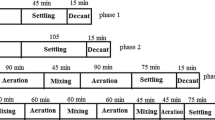Abstract
The purpose of this work was to determine optimum sequence retention times for nutrient removal with low-cost using very short aeration time in an SBR treating domestic wastewater. During the study, four different CYCLEs were evaluated, with the highest removal efficiencies recorded for the CYCLE with fill, anaerobic, aerobic1, anoxic, aerobic2, settle, and decant sequences operated at retention times of 0.5, 2, 2, 1, 0.75, 1, and 0.5 h, respectively. For this CYCLE, the removal efficiencies of chemical oxygen demand (COD), total Kjeldahl nitrogen (TKN), ammonia nitrogen (NH3–N), total phosphorus (TP), and ortho-phosphate (PO4–P) were found, on average, to be 91, 78, 85, 87, and 83%, respectively. The optimum sequence retention time was determined via the analysis of variance (ANOVA) using the Matlab software (Mathworks Inc.). The data indicated that the total time of the aerobic sequences was shorter than those of previous studies for similar level of removal efficiencies in all parameters including N and P.





Similar content being viewed by others
Abbreviations
- ANOVA:
-
Analysis of variance
- COD:
-
Chemical oxygen demand
- HRT:
-
Hydraulic retention time
- MLSS:
-
Mixed liquor suspended solids
- MLVSS:
-
Mixed liquor volatile suspended solids
- NH3–N:
-
Ammonia + ammonium nitrogen
- PO4–P:
-
Phosphate phosphorous
- RAS:
-
Return activated sludge
- SBR:
-
Sequencing batch reactor
- SVI:
-
Sludge volume index
- TKN:
-
Total Kjeldahl nitrogen
- TP:
-
Total phosphorous
References
United States Environmental Protection Agency, Sequencing batch reactors (1999) Wastewater technology fact sheet 832-F-99-073
Ersu CB, Arslankaya E, Ong SK, Fox D, Aldrich L, Copeman J (2008) Modification of a full-scale sequencing batch reactor operational mode for biological nutrient removal. Water Environ Res 80:257–266
Bing-Jie N, Wen-Ming X, Shao-Gen L, Han-Qing Y, Ying-Zhe W, Gan W, Xian-Liang D (2009) Granulation of activated sludge in a pilot-scale sequencing batch reactor for the treatment of low-strength municipal wastewater. Water Res 43:751–761
United States Environmental Protection Agency (2002) Onsite wastewater treatment systems manual. Office of Water, Office of Research and Development 625/R-00/008
Souza SM, Araujo OQF, Coelho MAZ (2008) Model-based optimization of a sequencing batch reactor for biological nitrogen removal. Bioresour Technol 99:3213–3223
Cybis LF, Santos AV, Gehling GR (2004) The sequencing batch reactor (SBR) efficiency in the removal of nitrogen on the treatment of domestic sewage with low COD. Eng Sanit Ambient 9:260–264
Umble AK, Ketchum LH (1997) A strategy for coupling municipal wastewater treatment using the sequencing batch reactor with effluent nutrient recovery through aquaculture. Water Sci Technol 35:177–184
Yu RF, Liaw SL, Chang CN, Cheng WY (1998) Applying real-time control to enhance the performance of nitrogen removal in the continuous-flow SBR system. Water Sci Technol 38:271–280
Manav N (2006) The removal of nitrogen and phosphorous from domestic wastewaters using sequencing batch reactors. M.Sc. Thesis, Yildiz Technical University, Institute of Science and Technology, Istanbul (in Turkish)
APHA (2005) Standard methods for the examination of water and wastewater, 21st edn. American Public Health Association, Washington
Metcalf E (2003) Wastewater engineering treatment and reuse. Tata McGraw-Hill, New Delhi
Tsuneda S, Ohno T, Soejima K, Hirata A (2006) Simultaneous nitrogen and phosphorus removal using denitrifying phosphate-accumulating organisms in a sequencing batch reactor. Biochem Eng J 27:191–196
Ya-Nan L, Shui-Li Y, Guo-Lin J, Bing-Jie Z, Si-Yuan G (2005) Enhanced biological phosphorus removal in anaerobic/aerobic sequencing batch reactor supplied with glucose as carbon source. J Donghua Univ 22:95–99
Third KA, Gibbs B, Newland M, Cord-Ruwisch R (2005) Long-term aeration management for improved N-removal via SNDin a sequencing batch reactor. Water Res 39:3523–3530
Bernat K, Wojnowska-Baryla I, Dobrzynska A (2008) Denitrification with endogenous carbon source at low C/N and its effect on P(3HB) accumulation. Bioresour Technol 99:2410–2418
Dosta J, Gali A, El-Hadj TB, Mace S, Mata-Alvarez J (2007) Operation and model description of a sequencing batch reactor treating reject water for biological nitrogen removal via nitrite. Bioresour Technol 98:2065–2075
Li H, Chen Y, Gu G (2008) The effect of propionic to acetic acid ratio on anaerobic–aerobic (low dissolved oxygen) biological phosphorus and nitrogen removal. Bioresour Technol 99:4400–4407
Lee DS, Jeon CO, Park JM (2001) Biological nitrogen removal with enhanced phosphate uptake in a sequencing batch reactor using single sludge system. Water Res 35:3968–3976
Bernardes RS, Klapwijk A (1996) Biological nutrient removal in a sequencing batch reactor treating domestic wastewater. Water Sci Technol 33:29–38
Surampalli RY, Tyagi RD, Scheible OK, Heidman JA (1997) Nitrification, denitrification and phosphorus removal in sequential batch reactors. Bioresour Technol 61:151–157
Casellas M, Dagot C, Baudu M (2006) Set up and assessment of a control strategy in a SBR in order to enhance nitrogen and phosphorus removal. Process Biochem 41:1994–2001
Rim YT, Yang HJ, Yoon CH, Kim YS, Seo JB, Ryu JK, Shin EB (1997) A full-scale test of a biological nutrients removal system using the sequencing batch reactor activated sludge process. Water Sci Technol 35:241–247
Cetin E, Yilmaz G, Temizsoy A (2005) The removal of nutrient from domestic wastewaters in sequencing batch reactors. II. Engineering Sciences Young Researchers Congress, Istanbul (in Turkish), 17–19 November 2005
Kargi F, Uygur A (2002) Nutrient removal performance of a sequencing batch reactor as a function of the sludge age. Enzyme Microb Technol 31:842–847
Akin BS, Ugurlu A (2005) Monitoring and control of biological nutrient removal in a sequencing batch reactor. Process Biochem 40:2873–2878
Kim IS, Kim SM, Jang A (2008) Characterization of aerobic granules by microbial density at different COD loading rates. Bioresour Technol 99:18–25
Wu C, Chen Z, Liu X, Peng Y (2007) Nitrification–denitrification via nitrite in SBR using real-time control strategy when treating domestic wastewater. Biochem Eng J 36:87–92
Author information
Authors and Affiliations
Corresponding author
Rights and permissions
About this article
Cite this article
Debik, E., Manav, N. Sequence optimization in a sequencing batch reactor for biological nutrient removal from domestic wastewater. Bioprocess Biosyst Eng 33, 533–540 (2010). https://doi.org/10.1007/s00449-009-0366-1
Received:
Accepted:
Published:
Issue Date:
DOI: https://doi.org/10.1007/s00449-009-0366-1




